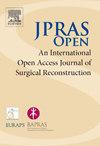在妇科整形手术中尽量减少疤痕的可用技术--综合评述
IF 1.5
Q3 SURGERY
引用次数: 0
摘要
目标妇科乳房肥大和脂肪瘤是男性乳房的良性增生,影响 32-65% 的男性。在进行皮肤切除时,许多外科手术往往会留下令人难堪的疤痕。本研究的目的是综述保皮技术,并介绍我们使用经皮网膜治疗皮肤过度增生的保皮方法。材料和方法对文献进行了全面综述,旨在确定避免妇科乳腺增生或脂肪瘤患者(Simon's IIb 级和 III 级)切除皮肤的可用技术。结果 七项研究详细介绍了皮肤牵拉技术,包括激光、超声波和射频辅助吸脂术(LAL、UAL 和 RAL)、微针注射和乳头乳晕复合体(NAC)石膏提拉术。所有文章都提供了西蒙等级分类,大多数研究包括皮肤松弛和非松弛患者。并发症发生率较低(1.5%-10%),患者满意度从 87.5% 到 100%不等。虽然有报道称经皮网术可减少妇科整形手术中的血肿,但没有研究专门探讨其在处理皮肤冗余方面的作用。虽然 LAL、UAL 和 RAL 显示出一定的潜力,但缺乏对照研究,而且皮肤切除通常是针对皮肤高度冗余进行的。对于西蒙氏 III 级以下的妇科乳腺增生,我们建议采用吸脂和经皮网切的方法来保留皮肤,这样可以进行皮肤牵拉和 NAC 固定。目前还没有文献评估经皮网膜在促进妇科整形皮肤回缩方面的效果。本文章由计算机程序翻译,如有差异,请以英文原文为准。
Available techniques to minimize scars in surgical management of gynecomastia – a comprehensive review
Objective
Gynecomastia and lipomastia are benign proliferations of the male breast affecting 32–65% of men. Numerous surgical procedures often result in stigmatizing scars when it comes to skin resection. The purpose of this study was to review skin-sparing techniques and to describe our skin-sparing approach to treat skin excess using transcutaneous netting.
Materials and Methods
A comprehensive review of the literature was conducted aiming at identifying available techniques to avoid skin resection in gynecomastia or lipomastia patients (Simon's grade IIb and III). Surgical techniques, patient satisfaction, time of follow-up, and complications were assessed.
Results
Seven studies detailed skin retraction techniques, including laser-, ultrasound-, and radiofrequency-assisted liposuction (LAL, UAL, and RAL), microneedling, and nipple-areolar complex (NAC) plaster lifting. All articles provided Simon's grade classification, with most studies including patients with and without skin laxity. Complication rates were low (1.5–10%), and patient satisfaction ranged from 87.5% to 100%.
While transcutaneous netting has been reported to reduce hematoma in gynecomastia surgery, no studies specifically examined its role in managing skin redundancy.
Conclusions
Limited data exist on scarless skin retraction techniques for gynecomastia. While LAL, UAL, and RAL show some potential, controlled studies are lacking, and skin resection is often performed for high skin redundancy. We recommend a skin-sparing approach using liposuction and transcutaneous netting for gynecomastia up to Simon's grade III, which allows for skin retraction and NAC fixation. No literature was found assessing the efficacy of transcutaneous netting in promoting skin retraction in gynecomastia.
求助全文
通过发布文献求助,成功后即可免费获取论文全文。
去求助
来源期刊

JPRAS Open
Medicine-Surgery
CiteScore
1.60
自引率
0.00%
发文量
89
审稿时长
22 weeks
期刊介绍:
JPRAS Open is an international, open access journal dedicated to publishing case reports, short communications, and full-length articles. JPRAS Open will provide the most current source of information and references in plastic, reconstructive & aesthetic surgery. The Journal is based on the continued need to improve surgical care by providing highlights in general reconstructive surgery; cleft lip, palate and craniofacial surgery; head and neck surgery; skin cancer; breast surgery; hand surgery; lower limb trauma; burns; and aesthetic surgery. The Journal will provide authors with fast publication times.
 求助内容:
求助内容: 应助结果提醒方式:
应助结果提醒方式:


